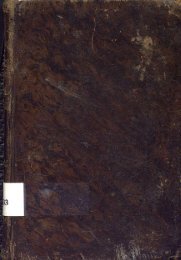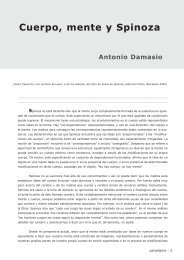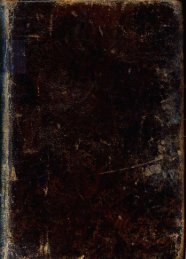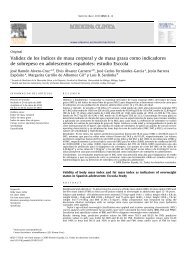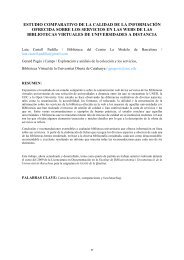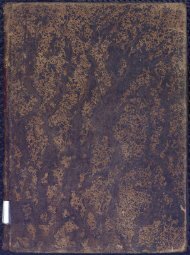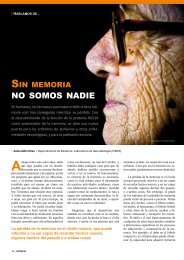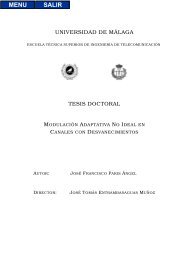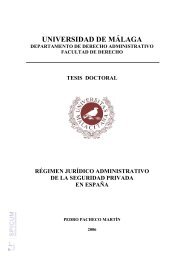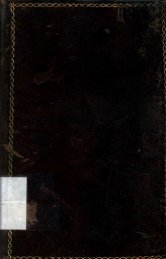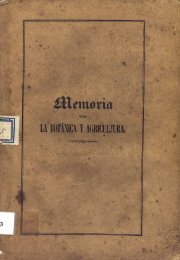Papel de las actividades superóxido dismutasa y catalasa en la ...
Papel de las actividades superóxido dismutasa y catalasa en la ...
Papel de las actividades superóxido dismutasa y catalasa en la ...
Create successful ePaper yourself
Turn your PDF publications into a flip-book with our unique Google optimized e-Paper software.
Journal of Fish Diseases 2006, 29, 355–364<br />
PDíaz-Rosales et al. Superoxi<strong>de</strong> dismutase and cata<strong><strong>la</strong>s</strong>e in P. damse<strong>la</strong>e ssp. piscicida<br />
superoxi<strong>de</strong> dismutases (SODs) and cata<strong><strong>la</strong>s</strong>es. Production<br />
of SOD and cata<strong><strong>la</strong>s</strong>e <strong>en</strong>zymes, which<br />
<strong>de</strong>compose superoxi<strong>de</strong> and peroxi<strong>de</strong> radicals,<br />
respectively, have be<strong>en</strong> reported to contribute to<br />
the virul<strong>en</strong>ce of a great number of pathog<strong>en</strong>s<br />
(Franzon, Aron<strong>de</strong>l & Sansonetti 1990; Lynch &<br />
Kuramitsu 2000; Lefebre & Valvano 2001; Uzzau,<br />
Bossi & Figueroa-Bossi 2002).<br />
Superoxi<strong>de</strong> dismutases are a family of metallo<strong>en</strong>zymes<br />
including four types <strong>de</strong>p<strong>en</strong>ding on the<br />
metal cofactor, copper-zinc (Cu/Zn-SOD), manganese<br />
(Mn-SOD), iron (Fe-SOD) and nickel<br />
(Ni-SOD) (Lynch & Kuramitsu 2000). Three<br />
types of cata<strong><strong>la</strong>s</strong>e have be<strong>en</strong> <strong>de</strong>scribed: monofunctional<br />
cata<strong><strong>la</strong>s</strong>es, bifunctional cata<strong><strong>la</strong>s</strong>es or cata<strong><strong>la</strong>s</strong>e/<br />
peroxidase and pseudocata<strong><strong>la</strong>s</strong>es or non-haeme<br />
cata<strong><strong>la</strong>s</strong>es, with manganese as a metal cofactor<br />
(Loew<strong>en</strong> 1997).<br />
Microorganisms produce differ<strong>en</strong>t SOD and<br />
cata<strong><strong>la</strong>s</strong>e isozymes inducible un<strong>de</strong>r certain culture<br />
conditions such as high oxyg<strong>en</strong> t<strong>en</strong>sion, low levels<br />
of iron or stationary growth phase (Crockford,<br />
Davis & Williams 1995; Schnell & Steinman 1995;<br />
Barnes, Horne & Ellis 1996; Po<strong>la</strong>ck, Dacheux,<br />
Delic-Attree, Toussaint & Vignais 1996; St John &<br />
Steinman 1996; Lynch & Kuramitsu 2000; Vattanaviboon<br />
& Mongkolsuk 2001). However, information<br />
on the SOD and cata<strong><strong>la</strong>s</strong>e activities of<br />
P. damse<strong>la</strong>e ssp. piscicida is scarce.<br />
The aim of this work was to <strong>de</strong>termine whether<br />
P. damse<strong>la</strong>e ssp. piscicida can express differ<strong>en</strong>t SOD<br />
and cata<strong><strong>la</strong>s</strong>e activities wh<strong>en</strong> cultured un<strong>de</strong>r differ<strong>en</strong>t<br />
conditions, and whether these <strong>en</strong>zymatic activities<br />
may protect the bacterium in vitro from oxyg<strong>en</strong><br />
radicals g<strong>en</strong>erated during the macrophage respiratory<br />
burst.<br />
Materials and methods<br />
Bacteria<br />
Strains of P. damse<strong>la</strong>e ssp. piscicida used in this<br />
study are listed in Table 1. Strains B180, D 26/98 ,<br />
Pp8H, R45, R46, B51 and Lg h41/01 were iso<strong>la</strong>ted in<br />
our <strong>la</strong>boratory (Departm<strong>en</strong>t of Microbiology, Faculty<br />
of Sci<strong>en</strong>ces, University of Má<strong>la</strong>ga, Spain).<br />
Strains MT 1415, MT 1375, MT 1376 and MT<br />
1379 were kindly provi<strong>de</strong>d by Dr A.C. Barnes<br />
(Marine Laboratory, Aber<strong>de</strong><strong>en</strong>, UK); strain DI-21S<br />
by Dr A.E. Toranzo (Departm<strong>en</strong>t of Microbiology<br />
and Parasitology, Faculty of Chemistry, University<br />
of Santiago <strong>de</strong> Composte<strong>la</strong>, Spain) and EPOY-<br />
8803-II by Dr K. Muroga (Faculty of Applied<br />
Biological Sci<strong>en</strong>ces, Hiroshima University, Hiroshima,<br />
Japan). Strains 17911 and 29690 were<br />
obtained from the American Type Culture Collection<br />
(ATCC).<br />
Virul<strong>en</strong>ce assays were carried out with two<br />
selected strains: Lg h41/01 and EPOY-8803-II. Assays<br />
to <strong>de</strong>termine the lethal dose 50% (LD 50 ) for sole,<br />
Solea s<strong>en</strong>egal<strong>en</strong>sis (Kaup), were carried out following<br />
the methodology <strong>de</strong>scribed by Santos (1991).<br />
Groups of five fish (10–15 g body weight) maintained<br />
in tanks at 24 °C, were intraperitoneally<br />
inocu<strong>la</strong>ted with 0.1 mL of serial bacterial dilutions<br />
containing 10 3 –10 8 cfu. The same number of fish<br />
was inocu<strong>la</strong>ted with phosphate-buffered saline<br />
(PBS) and used as a control. Inocu<strong>la</strong>ted fish were<br />
observed daily for 14 days, and all mortalities were<br />
recor<strong>de</strong>d. Mortalities were consi<strong>de</strong>red to be due to<br />
the inocu<strong>la</strong>tion wh<strong>en</strong> the bacterial strain was<br />
iso<strong>la</strong>ted in pure culture from internal organs of<br />
<strong>de</strong>ad fish. Lethal dose 50% (LD 50 ) repres<strong>en</strong>ts the<br />
Strain Host Source<br />
17911 Roccus americanus ATCC<br />
29690 Serio<strong>la</strong> quinqueradiata ATCC<br />
B51 Dic<strong>en</strong>trarchus <strong>la</strong>brax UMA, Spain<br />
B180 Sparus aurata UMA, Spain<br />
D 26/98 S. aurata UMA, Spain<br />
Pp8H S. aurata UMA, Spain<br />
R45 S. aurata UMA, Spain<br />
R46 S. aurata UMA, Spain<br />
DI-21S S. aurata USC, Spain<br />
EPOY-8803-II Epinephelus akaara Japan<br />
Lg h41/01 Solea s<strong>en</strong>egal<strong>en</strong>sis UMA, Spain<br />
MT1415 D. <strong>la</strong>brax Marine Laboratory, Aber<strong>de</strong><strong>en</strong>, UK<br />
MT1375 D. <strong>la</strong>brax Marine Laboratory, Aber<strong>de</strong><strong>en</strong>, UK<br />
MT1376 S. aurata Marine Laboratory, Aber<strong>de</strong><strong>en</strong>, UK<br />
MT1379 S. aurata Marine Laboratory, Aber<strong>de</strong><strong>en</strong>, UK<br />
Table 1 Photobacterium damse<strong>la</strong>e subsp.<br />
piscicida strains used in this study<br />
ATCC, American Type Culture Collection; UMA, University of Má<strong>la</strong>ga; USC, University of<br />
Santiago <strong>de</strong> Composte<strong>la</strong>.<br />
Ó 2006<br />
B<strong>la</strong>ckwell Publishing Ltd<br />
356



